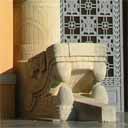0311 Folkloristic Cosmopolitanism: Mexico’s Indigenist Architectures at World’s Fairs and International Exhibitions
Identifiers (Article)
Abstract
In 1929, Mexico presented itself at the Ibero-American Exposition in Seville, Spain, with a pavilion architecture that replicated the aesthetics of 'Mexican antiquity', referring back to ancient Mexican construction types. Starting from this staging, this article examines the indigenist exhibition architectures in terms of the strategies used to represent the indigenous in the context of establishing a national canon of aesthetic forms. The example of Mexico enables a discussion on how 'peripheral modernism' was imagined at international exhibitions and world’s fairs, how it – in turn – was linked to exoticisation and auto-exoticisation, and which forms of staging were used, especially since no similarly large exhibitions took place in Mexico itself. In broad terms, the pivotal question is to what extent the world’s fair format provided a unique stage for negotiations between the poles of nationalism and cosmopolitanism, tradition and modernity, periphery and center. A special focus will be on the question in which architectural and artistic configurations these negotiation processes became visible. This entails retracing and reappraising the contexts of such indigenist aesthetics.
Statistics


License

This work is licensed under a Creative Commons Attribution-NonCommercial-NoDerivatives 4.0 International License.



